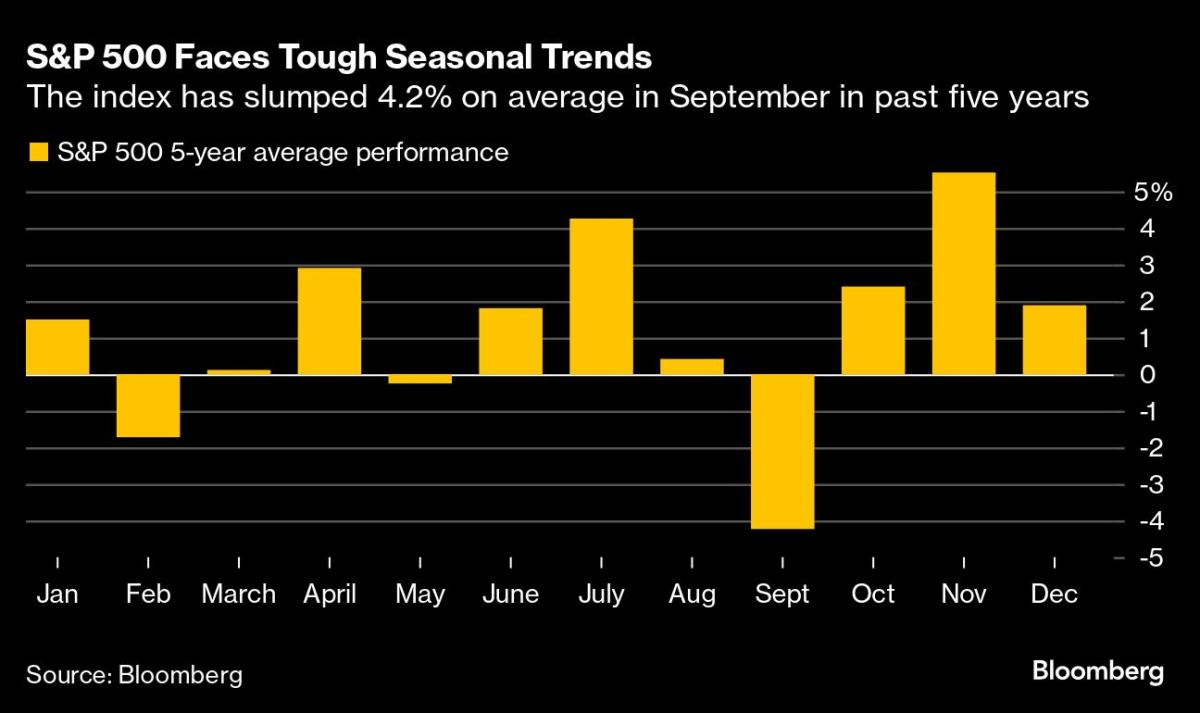(Bloomberg) — Asian equities were flat and the dollar and yen rallied against peers in a sign of defensive posturing as traders prepare for US data later this week that will offer clues on Federal Reserve rate cuts.
Most Read from Bloomberg
Stocks in Australia, Hong Kong and South Korea fell, while mainland China shares fluctuated. Shares in Japan trimmed earlier gains, but were among the best performers in the region, even as the yen strengthened. An index of global shares erased an earlier advance.
European equity futures were little changed, while US contracts fell ahead of Wall Street’s reopening later Tuesday, following the Labor Day public holiday. Treasuries were little changed.
As index of dollar strength reached a two-week high and was on pace for fifth daily advance. The yen’s climb ended a run of weakening against the greenback in the prior four trading days.
Pimco Japan Ltd. expects the Bank of Japan to raise rates again as early as January, but further hikes may not lead to a stronger yen, according to Julius Baer, which is preparing for further weakness in the currency.
“Our assumption is that the Bank of Japan policy rate will be half a percent by March next year and the fed funds rate will be 4.5% — that’s still 400 basis points of difference, which is very wide,”said Mark Matthews, head of Asia research on Bloomberg Television. “On that basis we do see the yen weakening.”
The South Korean won weakened after August inflation data showed year-over-year prices rose at the slowest pace since 2021. The Australian dollar fell as iron ore prices dropped.
Traders will be looking ahead to American manufacturing data due later Tuesday for clues about the health of the US economy in a busy week of economic reports that will reach a crescendo on Friday with the nonfarm payrolls data.
Markets are pricing a start to the US easing cycle this month, with a roughly one-in-four chance of a 50 basis-point cut, according to data compiled by Bloomberg.
“The markets may be leaning too dovish into the September Fed meeting,” Valentin Marinov, head of G-10 FX strategy at Credit Agricole CIB. said on Bloomberg Television. “The dollar could recoup some ground once the markets realized that the Fed will move more cautiously.”
Rates Impact
The equity market rally could stall even if the Fed initiates a rate cut, JPMorgan Chase & Co. strategists cautioned, as any policy easing would be in response to slowing growth, while the seasonal trend for September would be another impediment, the team led by Mislav Matejka wrote in a note.
“We are not out of the woods yet,” Matejka said, reiterating his preference for defensive sectors against the backdrop of a pullback in bond yields. “Sentiment and positioning indicators look far from attractive, political and geopolitical uncertainty is elevated, and seasonals are more challenging.”
Traders in Asia will be keeping a close eye on fresh signs of economic troubles in China. Data on Saturday showed Chinese factory activity had contracted for a fourth straight month in August, the latest signal that the world’s second-largest economy may struggle to meet this year’s growth target.
The slowdown in China has highlighted the urgency of fresh government stimulus, while inventories of key raw materials from steel to soybeans are piling up in the nation’s warehouses — evidence that economic activity remains too feeble to clear surpluses.
Demand for Chinese housing should start to stabilize next year, which would be “a key turning point for us in terms of market confidence,” in the country’s equity market, Lorraine Tan, director of Asia equity research for Morningstar, said on Bloomberg Television.
In commodities, oil edged higher after Libya declared force majeure at a key oil field amid widening shutdowns that have wiped out close to a million barrels from daily global supplies.
Elsewhere, the US is laying the groundwork for new sanctions on Venezuelan government officials in response to Nicolás Maduro’s disputed reelection in July. The country had ordered the arrest of presidential candidate Edmundo González, an escalation of the government’s crackdown on dissent in the wake of the vote.
Key events this week:
-
Switzerland GDP, CPI, Tuesday
-
US construction spending, ISM Manufacturing index, Tuesday
-
Australia GDP, Wednesday
-
China Caixin services PMI, Wednesday
-
Euro-zone HCOB services PMI, PPI, Wednesday
-
Fed’s Beige Book, Wednesday
-
Eurozone retail sales, Thursday
-
Germany factory orders, Thursday
-
US initial jobless claims, ADP employment, ISM services index, Thursday
-
Euro-zone GDP, Friday
-
US nonfarm payrolls, Friday
Some of the main moves in markets:
Stocks
-
S&P 500 futures fell 0.1% as of 6:52 a.m. London time
-
Nasdaq 100 futures fell 0.3%
-
Futures on the Dow Jones Industrial Average fell 0.2%
-
The MSCI Asia Pacific Index was little changed
-
The MSCI Emerging Markets Index fell 0.4%
-
Japan’s Topix rose 0.5%
-
Australia’s S&P/ASX 200 fell 0.1%
-
Hong Kong’s Hang Seng fell 0.5%
-
The Shanghai Composite fell 0.5%
-
Euro Stoxx 50 futures were little changed
Currencies
-
The Bloomberg Dollar Spot Index rose 0.1%
-
The euro fell 0.1% to $1.1056
-
The Japanese yen rose 0.4% to 146.31 per dollar
-
The offshore yuan was little changed at 7.1228 per dollar
-
The British pound fell 0.2% to $1.3118
Cryptocurrencies
-
Bitcoin rose 0.3% to $59,203.86
-
Ether fell 1.3% to $2,520.82
Bonds
-
The yield on 10-year Treasuries was little changed at 3.91%
-
Germany’s 10-year yield advanced four basis points to 2.34%
-
Britain’s 10-year yield advanced four basis points to 4.05%
-
Australia’s 10-year yield was little changed at 4.00%
Commodities
-
Spot gold fell 0.2% to $2,495.22 an ounce
-
West Texas Intermediate crude rose 0.8% to $74.13 a barrel
This story was produced with the assistance of Bloomberg Automation.
–With assistance from Jason Scott.
(An earlier version corrected the date that Chinese factory data came out.)
Most Read from Bloomberg Businessweek
©2024 Bloomberg L.P.





